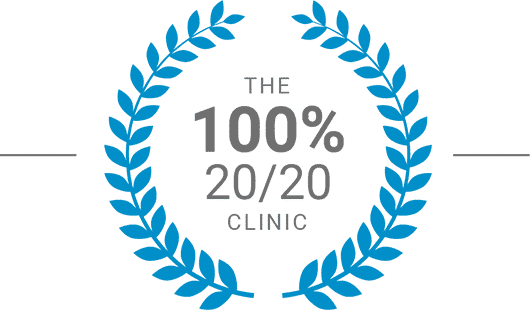Book Your Free Consultation
Mr David Allamby
MD, FRCOphth, FRCS
If you’re one of the millions living with visual impairment and reliant on glasses or contact lenses, you may have considered laser eye surgery as an alternative.
However, LASIK, the most commonly recommended refractive surgery, is not suitable for everyone, and in these instances, many people are offered LASEK surgery as an alternative.
But what is LASEK surgery, and how is it different from other refractive eye surgeries?
LASEK (laser epithelial keratomileusis) is a form of corrective eye surgery that is the most common alternative to LASIK; LASEK can treat astigmatism, long-sight, short-sight and reading glasses.
LASEK is also commonly referred to as PRK (photorefractive keratectomy).
LASEK uses laser and surgical manipulation to correct the eye’s cornea to improve sight, taking around 15-20 minutes for both eyes.
We can simplify the LASEK procedure into the following steps:
LASEK surgery involves elements similar to PRK and LASIK surgery, but each has advantages and disadvantages.
Although the surgeries are different, there are similarities between LASEK, PRK, and LASIK.
All three treatments use an excimer laser to reshape the cornea and correct vision, but the LASIK procedure uses a second laser to create a flap on the cornea’s surface to reshape the tissue beneath.
PRK and LASEK are almost the same procedure.
PRK involves removing the cornea’s surface layer before reshaping the cornea, allowing epithelial skin tissue to grow naturally. LASEK treatment involves loosening and detaching the surface layer of the corneal epithelium before replacing it and allowing it to heal.
LASEK surgery evolved from PRK to reduce the risk of corneal haze, a fine layer of scar tissue that can develop on the cornea in the months following treatment, particularly with higher prescriptions and UV exposure.
Most surgeons now use a PRK approach. The reason is due to the discovery of mitomycin C (MMC), which prevents haze formation on the corneal surface. MMC is applied for a short time during the procedure and is highly effective at preventing haze without the need to replace the epithelium.
The epithelium grows back smoother and more quickly after removing the original layer, as in PRK.
LASEK eye surgery (and PRK) does have several good things going for it.
Firstly, LASEK is less likely to have corneal flap complications associated with LASIK surgery as only the epithelium is cut.
Secondly, and again related to the epithelium, patients are less likely to suffer from dry eyes, which is again more common in LASIK patients.
Another positive for LASEK eye surgery is that there is less possibility of something going wrong as the cornea itself is not cut into, so there is less chance of structural damage to the eye.
Lastly, there is less risk of the flap being displaced in case of head or eye injury.
Although there is less risk of dry eyes, this can be a side effect of LASEK eye surgery. Other possible side effects are haloed vision at night and a glare effect in the dark.
LASEK eye surgery will result in blurry vision and some discomfort or pain for the first few days as the eyes heal, and the overall healing time is longer than that of LASIK eye surgery as it is more intrusive.
LASEK eye surgery can also take a bit longer to complete than LASIK but is nonetheless a short procedure.
LASEK (or PRK) permanently changes the shape of your cornea and will significantly improve your distance eyesight, often for the rest of your life.
However, your eyes will continue to age naturally after the procedure, so contact or glasses may still be needed later in life.
Generally, LASIK is the preferred correction method as it offers the shortest recovery time. However, only some people are suitable for the procedure, especially in cases where the patient might have a high prescription or thin corneas.
To be suitable for LASEK surgery at Focus Clinics, you must meet the following criteria:
This is not an exhaustive list. Other factors, such as engaging in contact sports, having a high prescription or thin corneas, can affect your suitability for treatment.
If you’re considering refractive surgery and believe you may be suitable for LASEK, book a free telephone consultation with a member of our team, and they can discuss treatment options relevant to your prescription and lifestyle.
Considering LASEK eye surgery? Book a free telephone consultation and speak to one of our expert eye surgeons to see if LASEK surgery is right for you. Contact us here.
More information about LASEK surgery can be found here:
Book a FREE* Consultation
To get a better idea of how we can help you, and also the different types of services we offer, book a consultation now.

100% 20/20 vision
Focus Clinic has a remarkable 100% success rate for 20/20 vision. We know of no other clinic that has matched these results. There is a big difference between, for example, 98% and 100% success, especially if you are in the 2%.

10 year guarantee
Your 10 Year Guarantee means you can return at any time if you have additional questions on the quality of your vision. If you have distance vision correction for short-sight then any repeat laser eye treatments to correct a return of myopia in the first 10 years are included free of charge.*

Most trusted eye treatment clinic
We have the highest trust rating of any ‘eye treatment’ rated clinic, according to independent review site TrustPilot. With an outstanding 9.9 out of 10, when it comes to your eyes, choose the clinic that actual patients trust the most.
*Terms and conditions apply, excludes any age-related changes and conditions unrelated to the primary treatment